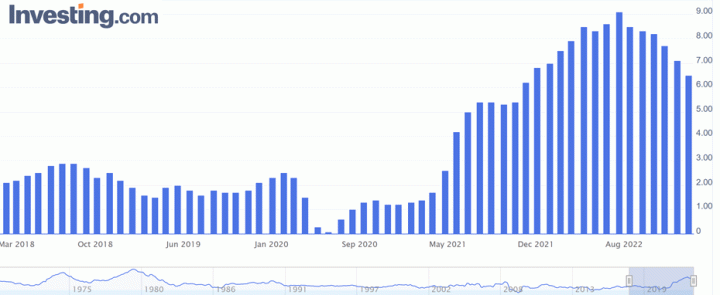
The Fed's use of data-dependent decisions can't be applicable only when it supports their beliefs
Considering that as recently as June we had the highest level of inflation recorded in the last 40 years today’s CPI report from December was a welcome change as inflation continues to slowly dissipate. Just six months ago overall inflation peaked at an alarming 9.1%. The historical rise in inflation was a long process after coming in at 0.329% in April and 0.118% in May 2020.
Initially, inflation was slow to rise with inflation concluding in December 2020 at 0.812. It was January 2020 that had the highest monthly level of inflation of 2.487%. Still the average level of inflation that year was 1.234%. An action by the Federal Reserve was logical in that inflation was running substantially below its 2% target.
In 2021 inflation concluded with an annual average of inflation at 4.698%. In March of that year, inflation had breached the 2% target set by the Federal Reserve by 0.62% and began to steadily climb higher with almost each following consecutive month coming in hotter than the previous month. Inflation rose past 4% in April, close to 5% in May, and finished the year at an alarming level of 7.036%.
Yet the Federal Reserve did nothing maintaining the belief that the recent jump in inflation was transitory and as such would dissipate without any influence by the Federal Reserve. It was this incorrect assumption that resulted in a level of inflation add speak that had not been witnessed in 40 years. In January 2022 levels of inflation continue to elevate higher beginning at 7.48% in January and peeking just above 9% in June. Still, the Federal Reserve continued to falsely believe that a 40-year high and inflation would dissipate on its own. One of the greatest errors by the Federal Reserve in recent history in both their forward guidance and projections that resulted in the most inappropriate action possible is to do nothing as inflation continues to spiral.
I believe that the Federal Reserve is once again creating one of the greatest errors by the Federal Reserve in recent history. It wasn’t that long ago that the Federal Reserve when asked about their forward guidance would quickly refer to their goto response: our actions will be data dependent and determine our forward guidance to shape our decisions in regards to our monetary policy.
Since June when inflationary pressures peaked at 9.1% we have seen inflationary levels have a methodically consistent and consecutive decline reducing inflation by approximately one-third. While we still have a ways to go to reach the fed’s 2% target, it is evident that the recent action of the Federal Reserve has accomplished its intent and effectively lowered inflation. However, it has been an overwhelming consensus by Federal Reserve members that they will continue to keep interest rates elevated and possibly even implement another rate hike to reach their goal of just over 5.

Will the FED make a blunder by not following the data
Will the FED make a blunder by not following the data which reveals its time to slowly reduce rates? It seems obvious to this author that the Federal Reserve did not learn anything from its incredible mistake of waiting too long to raise rates because of its false narrative that inflation was temporary, not persistent. Now they are making another tremendous mistake disregarding the data as they used to believe that the best forward guidance they can offer is to maintain elevated rates when what is needed is rate stabilization and reduction during 2023. Members of the Federal Reserve are assumed to be experts in their field and to disregard the data is a tremendous blunder in judgment.
The doctrine of being data-dependent when it fits assumptions right or wrong and abandoning that technique when they’re convinced again that they are right is a mistake. Members of the Federal Reserve should know better.
By Gary Wagner
Contributing to kitco.com
David